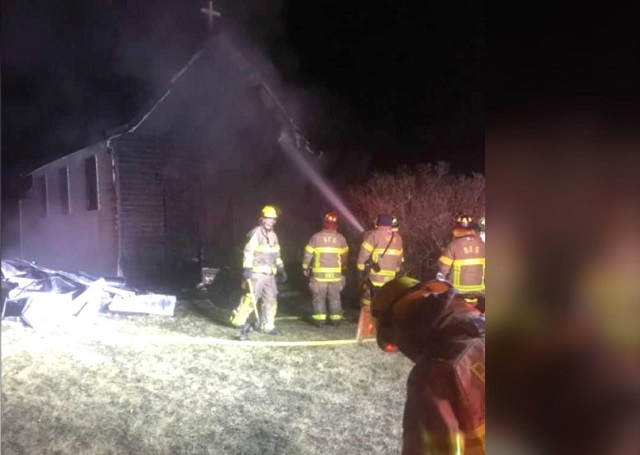Alberta
Two more historic churches in Canada set ablaze by arsonists

From LifeSiteNews
“These are absolutely despicable attacks on the Christian community”
Two historic Christian churches in Canada were intentionally set on fire late last week in what police said were suspected acts of arson.
The incident has Conservative political leaders calling for an end to “attacks” on Christianity after more than 100 churches having been targeted with arson or vandalism since 2021.
The Royal Canadian Mounted Police (RCMP) say St. Aidan’s Church, known as Glenreagh Church, and Pioneer Church, a United Church, both located in Barrhead, a town 120 miles northwest of Alberta’s capital Edmonton, were destroyed by arson within only two hours of each other on the evening of December 7.
No one was reported to have been hurt in the fires, but both churches have been extensively damaged, likely beyond repair, despite the best efforts of the Barrhead Fire Services, which was onsite quickly.
Barrhead RCMP confirmed that an initial investigation has determined that both fires were intentionally set. However, an exact motive is not yet clear.
According to eyewitnesses on the ground, two older pickup trucks were seen fleeing the scene.
An initial investigation by fire examiners confirmed that both fires were deliberately set.
Local resident Edith Strawson, whose dad helped build St. Aidan’s Church over 100 years ago, and who got married in the church, as well as some of her kids, said, “We’re putting this back together.”
“We just can’t let that happen and just leave it,” she said as per a CTV report.
Attacks on Christianity ‘must’ stop say conservative leaders
Leader of the Conservative Party of Canada (CPC) Pierre Poilievre condemned the attacks.
“These are absolutely despicable attacks on the Christian community,” Poilievre wrote Friday on X (formerly Twitter).
“Police must find and arrest the criminals responsible for setting fire to these two churches.”
These are absolutely despicable attacks on the Christian community.
Police must find and arrest the criminals responsible for setting fire to these two churches. https://t.co/ZKUHpaLrzu pic.twitter.com/c7Xxn8qMjb
— Pierre Poilievre (@PierrePoilievre) December 8, 2023
Alberta Premier Danielle Smith, the leader of the United Conservative Party, said church burnings have “no place in Alberta” and those who destroyed the churches by arson need to stand for their “crimes.”
She also confirmed that the RCMP is investigating the church fires “as suspected cases of arson.”
“Images like these have no place in Alberta,” Smith wrote Friday on X (formerly Twitter).
“To the parishioners of these churches and to the Christian community across our province, I stand in solidarity with you against all forms of hate.”
Images like these have no place in Alberta.
RCMP are investigating two churches which were destroyed by fires as suspected cases of arson.
To the parishioners of these churches and to the Christian community across our province, I stand in solidarity with you against all… pic.twitter.com/KmdQ3vc98S
— Danielle Smith (@ABDanielleSmith) December 8, 2023
Smith said that the church burnings “are condemned in the strongest possible terms and those perpetrating these crimes must be brought to justice.”
“I am closely monitoring this unfolding situation along with Minister of Public Safety and Emergency Services Mike Ellis,” she added.
Since the spring of 2021, well over 100 churches, most of them Catholic, but all Christian have either been burned or vandalized across Canada. The attacks on the churches came shortly after the unconfirmed discovery of “unmarked graves” at now-closed residential schools once run by the Church in parts of the country.
In 2021 and 2022, the mainstream media ran with inflammatory and dubious claims that hundreds of children were buried and disregarded by Catholic priests and nuns who ran some of the schools.
Despite the church burnings, the federal government under Prime Minister Justin Trudeau has done nothing substantial to bring those responsible to justice, nor to stem the root cause of the burnings.
Instead, a little over a month ago, Liberal and NDP Members of Parliament (MPs) struck down a Conservative Party of Canada motion that would have condemned incidents of church burnings and acts of vandalism.
In August of 2022, LifeSiteNews reported about the destruction by fire of one of the oldest standing Catholic churches in Alberta. Police at the time said the fire was a “suspicious” incident.
Despite the massive number of church fires in Canada, Canadian Heritage Minister Pablo Rodriguez in May made a brazen suggestion recently that the recent slew of anti-Christian church burnings in Canada could be remedied through further “online” internet regulation.
Those with any information on the church fires are asked to contact Barrhead RCMP at 403-780-674-4848.
Alberta
Housing in Calgary and Edmonton remains expensive but more affordable than other cities

From the Fraser Institute
By Tegan Hill and Austin Thompson
In cities across the country, modest homes have become unaffordable for typical families. Calgary and Edmonton have not been immune to this trend, but they’ve weathered it better than most—largely by making it easier to build homes.
Specifically, faster permit approvals, lower municipal fees and fewer restrictions on homebuilders have helped both cities maintain an affordability edge in an era of runaway prices. To preserve that edge, they must stick with—and strengthen—their pro-growth approach.
First, the bad news. Buying a home remains a formidable challenge for many families in Calgary and Edmonton.
For example, in 2023 (the latest year of available data), a typical family earning the local median after-tax income—$73,420 in Calgary and $70,650 in Edmonton—had to save the equivalent of 17.5 months of income in Calgary ($107,300) or 12.5 months in Edmonton ($73,820) for a 20 per cent down payment on a typical home (single-detached house, semi-detached unit or condominium).
Even after managing such a substantial down payment, the financial strain would continue. Mortgage payments on the remaining 80 per cent of the home’s price would have required a large—and financially risky—share of the family’s after-tax income: 45.1 per cent in Calgary (about $2,757 per month) and 32.2 per cent in Edmonton (about $1,897 per month).
Clearly, unless the typical family already owns property or receives help from family, buying a typical home is extremely challenging. And yet, housing in Calgary and Edmonton remains far more affordable than in most other Canadian cities.
In 2023, out of 36 major Canadian cities, Edmonton and Calgary ranked 8th and 14th, respectively, for housing affordability (relative to the median after-tax family income). That’s a marked improvement from a decade earlier in 2014 when Edmonton ranked 20th and Calgary ranked 30th. And from 2014 to 2023, Edmonton was one of only four Canadian cities where median after-tax family income grew faster than the price of a typical home (in Calgary, home prices rose faster than incomes but by much less than in most Canadian cities). As a result, in 2023 typical homes in Edmonton cost about half as much (again, relative to the local median after-tax family income) as in mid-sized cities such as Windsor and Kelowna—and roughly one-third as much as in Toronto and Vancouver.
To be clear, much of Calgary and Edmonton’s improved rank in affordability is due to other cities becoming less and less affordable. Indeed, mortgage payments (as a share of local after-tax median income) also increased since 2014 in both Calgary and Edmonton.
But the relative success of Alberta’s two largest cities shows what’s possible when you prioritize homebuilding. Their approach—lower municipal fees, faster permit approvals and fewer building restrictions—has made it easier to build homes and helped contain costs for homebuyers. In fact, homebuilding has been accelerating in Calgary and Edmonton, in contrast to a sharp contraction in Vancouver and Toronto. That’s a boon to Albertans who’ve been spared the worst excesses of the national housing crisis. It’s also a demographic and economic boost for the province as residents from across Canada move to Alberta to take advantage of the housing market—in stark contrast to the experience of British Columbia and Ontario, which are hemorrhaging residents.
Alberta’s big cities have shown that when governments let homebuilders build, families benefit. To keep that advantage, policymakers in Calgary and Edmonton must stay the course.
Alberta
Danielle Smith slams Skate Canada for stopping events in Alberta over ban on men in women’s sports

From LifeSiteNews
The Alberta premier has denounced Skate Canada as ‘disgraceful’ for refusing to host events in the province because of a ban on ‘transgender’ men in women’s sports.
Alberta Premier Danielle Smith has demanded an apology after Skate Canada refused to continue holding events in Alberta.
In a December 16 post on X, Smith denounced Skate Canada’s recent decision to stop holding competitions in Alberta due to a provincial law keeping gender-confused men from competing in women’s sports.
“Women and girls have the right to play competitive sports in a safe and fair environment against other biological females,” Smith declared. “This view is held by a vast majority of Albertans and Canadians. It is also common sense and common decency.”
Women and girls have the right to play competitive sports in a safe and fair environment against other biological females.
This view is held by a vast majority of Albertans and Canadians. It is also common sense and common decency.
Skate Canada‘s refusal to hold events in… pic.twitter.com/n4vbkTx6B0
— Danielle Smith (@ABDanielleSmith) December 16, 2025
“Skate Canada‘s refusal to hold events in Alberta because we choose to protect women and girls in sport is disgraceful,” she declared.
“We expect they will apologize and adjust their policies once they realize they are not only compromising the fairness and safety of their athletes, but are also offside with the international community, including the International Olympic Committee, which is moving in the same direction as Alberta,” Smith continued.
Earlier this week, Skate Canada announced their decision in a statement to CBC News, saying, “Following a careful assessment of Alberta’s Fairness and Safety in Sport Act, Skate Canada has determined that we are unable to host events in the province while maintaining our national standards for safe and inclusive sport.”
Under Alberta’s Fairness and Safety in Sport Act, passed last December, biological men who claim to be women are prevented from competing in women’s sports.
Notably, Skate Canada’s statement failed to address safety and fairness concerns for women who are forced to compete against stronger, and sometimes violent, male competitors who claim to be women.
Under their 2023 policy, Skate Canada states “skaters in domestic events sanctioned by Skate Canada who identify as trans are able to participate in the gender category in which they identify.”
While Skate Canada maintains that gender-confused men should compete against women, the International Olympic Committee is reportedly moving to ban gender-confused men from women’s Olympic sports.
The move comes after studies have repeatedly revealed what almost everyone already knew was true, namely that males have a considerable innate advantage over women in athletics.
Indeed, a recent study published in Sports Medicine found that a year of “transgender” hormone drugs results in “very modest changes” in the inherent strength advantages of men.
Additionally, male athletes competing in women’s sports are known to be violent, especially toward female athletes who oppose their dominance in women’s sports.
Last August, Albertan male powerlifter “Anne” Andres was suspended for six months after a slew of death threats and harassments against his female competitors.
In February, Andres ranted about why men should be able to compete in women’s competitions, calling for “the Ontario lifter” who opposes this, apparently referring to powerlifter April Hutchinson, to “die painfully.”
Interestingly, while Andres was suspended for six months for issuing death threats, Hutchinson was suspended for two years after publicly condemning him for stealing victories from women and then mocking his female competitors on social media. Her suspension was later reduced to a year.
-

 Crime9 hours ago
Crime9 hours agoBrown University shooter dead of apparent self-inflicted gunshot wound
-

 Business2 days ago
Business2 days agoOttawa Pretends To Pivot But Keeps Spending Like Trudeau
-

 Business20 hours ago
Business20 hours agoCanada Hits the Brakes on Population
-

 Energy2 days ago
Energy2 days agoLiberals Twisted Themselves Into Pretzels Over Their Own Pipeline MOU
-

 Censorship Industrial Complex2 days ago
Censorship Industrial Complex2 days agoHow Wikipedia Got Captured: Leftist Editors & Foreign Influence On Internet’s Biggest Source of Info
-

 Crime1 day ago
Crime1 day agoBondi Beach Survivor Says Cops Prevented Her From Fighting Back Against Terrorists
-

 International1 day ago
International1 day agoHouse Rejects Bipartisan Attempt To Block Trump From Using Military Force Against Venezuela
-

 Frontier Centre for Public Policy22 hours ago
Frontier Centre for Public Policy22 hours agoCanada Lets Child-Porn Offenders Off Easy While Targeting Bible Believers










